
With the acute focus on student-centric content in today’s digital marketing world, it is no surprise that many schools are turning to their current students and alumni to help build your school’s brand reputation on social media.
Coupled with the fact that prospects are more likely to trust something that a person says over something said by a company, you’ve got a foolproof recipe for recruitment success with student brand ambassadors.
But as with every new digital marketing tactic, many schools have questions about what, exactly, student ambassadors are and how they can impact admissions. Our blog endeavors to answer these questions, as well as show your school how it can go about adding this tactic to its higher ed social media strategy.

What are Social Media Student Brand Ambassadors?
Although social media brand ambassadors may sound like an indefinitely millennial marketing tactic, it has roots in other, more traditional marketing tactics that date back decades.
Think about how many times you’ve watched a celebrity—whether they be a musician, athlete, or movie star—endorse a product on television. Social media brand ambassadors aren’t too different. Both usually involve long-term contracts between the individual and the institution, as well as a scheduled series of content (whether that be TV ads or Instagram Stories).
Now, the so-called ‘contracts’ between a school and its student ambassadors will likely be a lot less intense than that of Jennifer Anniston and smartwater, but the premise is the same: students commit to promoting your brand on social media.
Essentially, your school’s student ambassadors serve as a student liaison between your school and its prospective students, showing prospects what your school is like from an insider’s perspective.
Example: An Instagram post by one of UNC Charlotte’s social media ambassadors.

In some cases, a student ambassador’s role is focused solely on social media content. In other cases, they take a more active role, participating in your school’s recruitment events and essentially acting as an ambassador both online and on campus.
The Effectiveness of Student Ambassadors on Social Media for Education
The rise of student brand ambassadors—or ‘influencer marketing’ as it’s called more generally—coincides with the public’s craving for authenticity in marketing.
With advertisements at every digital turn, whether you’re browsing the internet or opening up your email inbox, the public has become increasingly skeptical of overly promotional or sales-oriented marketing claims. This is especially the case for the young adult population who have grown up in a world saturated with digital advertising.
Now, this in no means suggests that schools should abandon all hope of recruiting prospective students online. In fact, areas of the internet like social media, search engines, and your prospect’s inbox are the areas where prospects expect to gather education-related information.
However, what this does mean is that your prospective students will be much more receptive to authentic marketing—or, in other words, marketing initiatives that involve real students, real opinions, and real experiences.
In fact, a 2020 study by Intead and Unibuddy found that students now rely more on the opinions of current students than that of friends and family, who have long been considered the most influential recruitment resource:

With all that said, it makes sense why influencer marketing has become a go-to marketing tactic for schools and businesses alike.
There is no shortage of statistics that prove why student brand ambassadors are worth investing in, and given the effectiveness of this tactic, you shouldn’t expect these numbers to change anytime soon. Take a look at some facts and figures here:

Although these statistics don’t specifically pertain to the education sector, it is easy to see why this digital marketing tactic is particularly helpful for schools.
For starters, it is typically much easier for prospective students to relate to a student ambassador—after all, that could be them in a couple of years. Seeing what your school’s campus is like from the eyes of a student provides a perspective that prospecs are more likely to trust. After all, it is one thing for a prospective student to read about your school’s courses and clubs on your website, but it’s another thing to see someone participating in them.
Another element that makes influencer marketing so successful is authenticity. Brand ambassadors aren’t anonymous—they are real people who have chosen to share content about a school on their personal social profile, a profile which they likely also use to communicate with friends and family. To publicly associate with a brand is a bold statement, so prospective students are more likely to trust this type of endorsement.
Now, that is just the theory behind student brand ambassadors. But thankfully these theories have proven true in the success of many school’s influencer marketing campaigns.
Angi Roberts of University of Guelph found that “in the first semester of [University of Guelph’s] social media ambassador programme, Twitter engagement increased by 45 percent, Instagram saw a 560 percent increase in likes, and Tumblr saw a rise in submitted questions – more than double of the total from the previous semester.”
Using Student Ambassadors for Higher Ed Social Media
Now that we’ve gone through what influencer marketing is and how it impacts social media for schools, we can start talking about what, exactly, a student ambassador can do for your school.
There are endless ways your student ambassadors can promote your school on their social profiles. The advantage of having social media-savvy students helping with recruitment is that they already have their finger on the pulse when it comes to social media trends. Here are just a few ways that influencers can help build your school’s brand on social media.
Showcasing Your Campus
A prospect interested in your school likely has a pretty good idea of what it looks like from an outside perspective, but student brand ambassadors provide that insider’s insight that can make your school feel like home even before they enroll.
Example: A YouTube video by Sonali Prabhu, a University of Central Florida (UCF) student ambassador highlighting the top 10 study spots on campus. Sonali has amassed over 25k subscribers sharing UCF content—a win for both the school and Sonali’s personal brand!
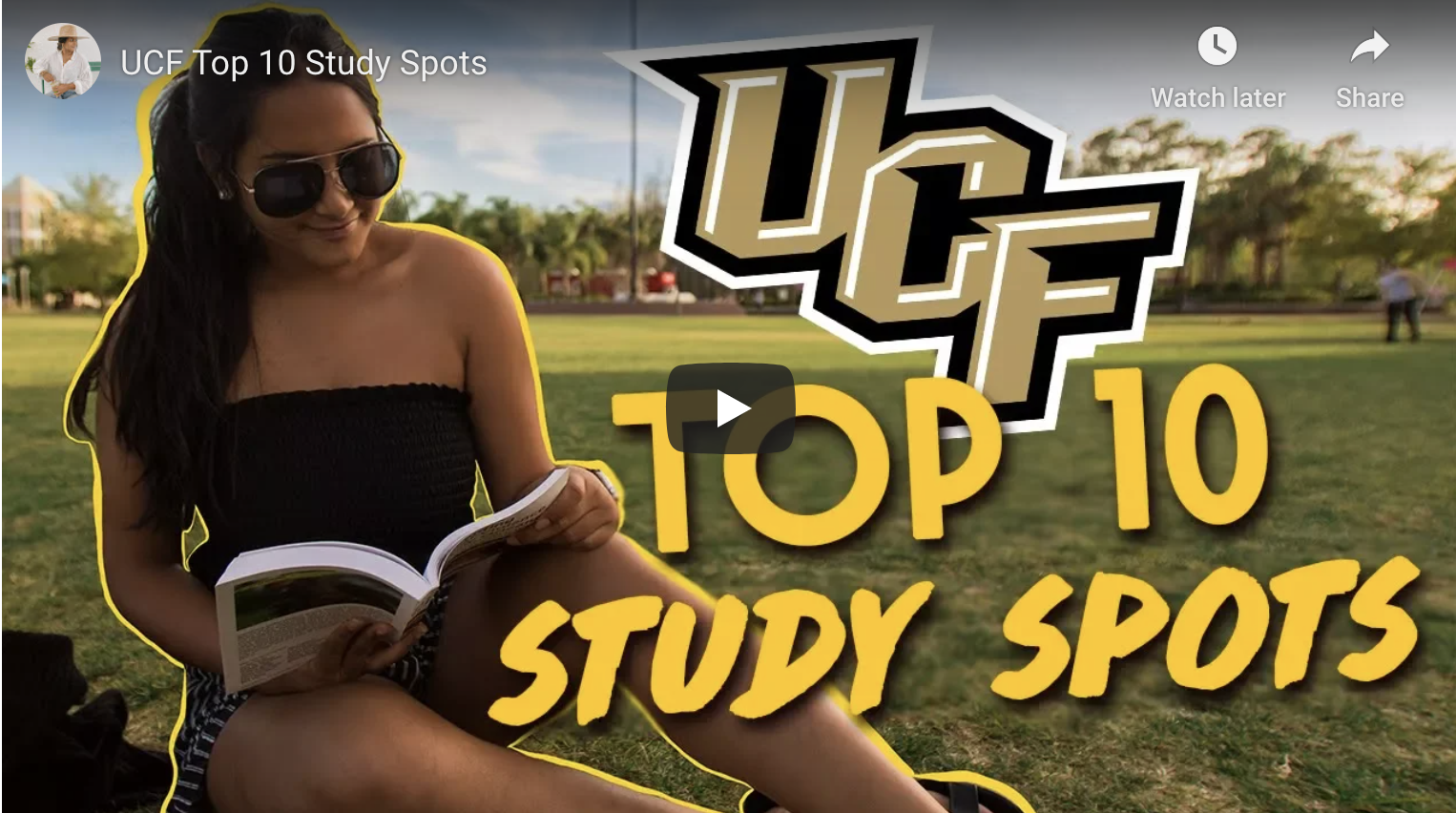
Sonali’s YouTube channel provides a wealth of UCF info for future students, from vlogs (video blogs) showcasing a typical day as a UCF student to Q&A videos answering admissions questions:

Faculty or Program-Specific Ambassadors
The above examples show a student ambassador whose role it is to showcase your school in general. However, depending on what your school wants to achieve with its brand ambassador program, you may want to have student influencers dedicated to promoting specific programs or faculties.
Example: An Instagram post from a University of Alberta brand ambassador who shares promoting the school’s Faculty of Engineering.

Highlighting new Initiatives, Events, Clubs, and More
Student ambassador posts are also a great way to share timely content with your school’s prospective students. Whether you’ve got a recruitment event coming up, or your school has just launched a new program, student influencers can help spread the word.
Example: An Instagram post highlighlighting the ‘Helping Hand’ project at Bristol Community College.
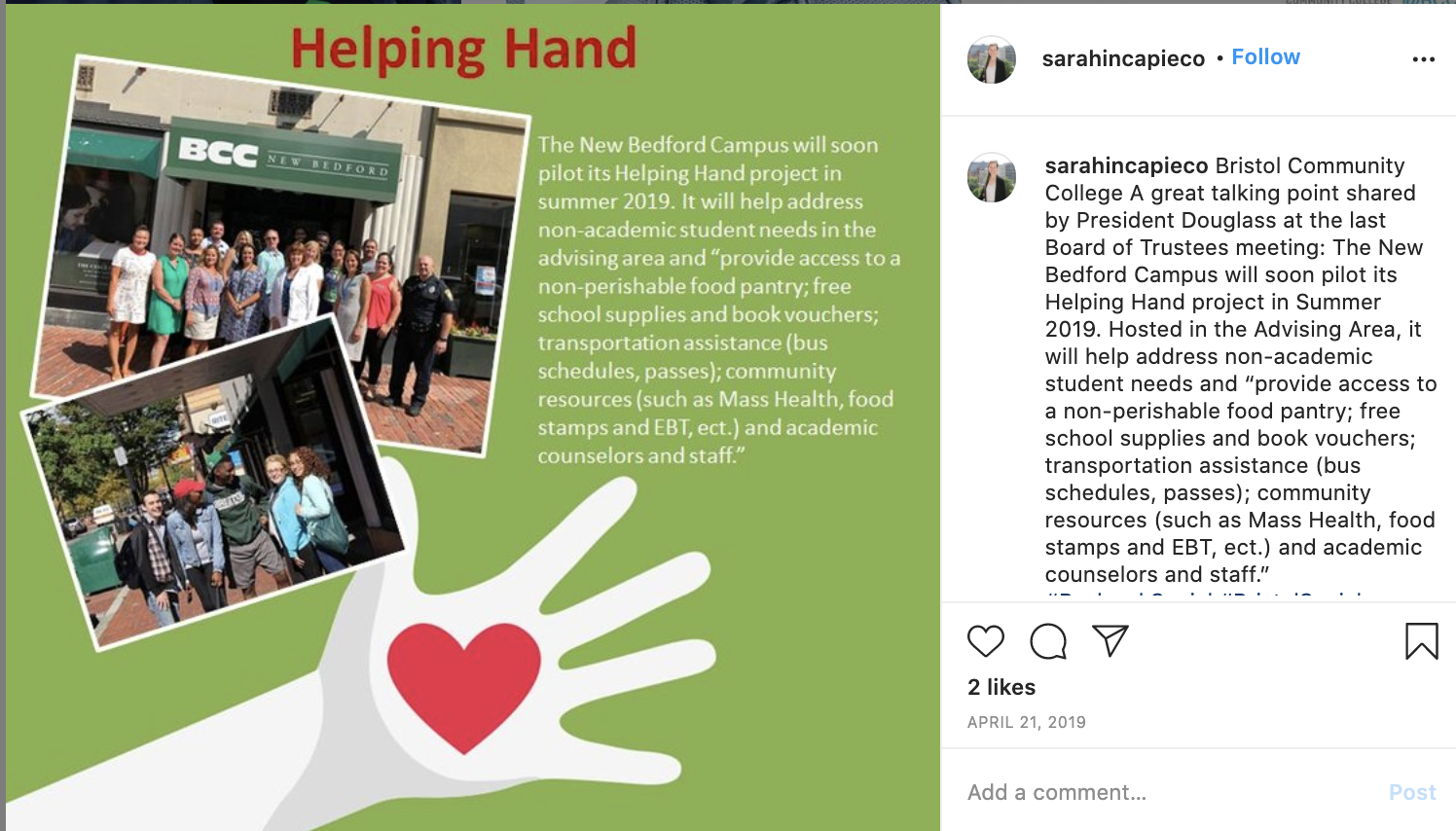
How to Recruit Student Ambassadors for Social Media for Education
By this point in the blog, if your school hasn’t made student brand ambassadors part of your social media for education strategy, you may be starting to reconsider. If this describes your school, we’re going to show you how to get started with a program of your own.
To find students who are both social media savvy and full of campus pride, create a page on your school’s website dedicated to your upcoming program. Just like a job posting, make sure to include the skills you’re looking for as well as the responsibilities a student ambassador will have.
Each school has a unique approach to this digital marketing tactic. Some take a hands-off approach to the tactic, providing general guidance on the type of content they’re looking for, but leaving it up to students to decide what they want to share.
Others take a more structured approach—especially if they’re paying their student ambassadors or providing them with volunteer credits. In this case, schools may ask ambassadors for a minimum number of posts and stories per month, as well as the promotion of specific events or programs.
Regardless of the approach you take, it’s important to make sure that you clearly define what you’re looking for in a student ambassador before you launch the program.
Example: Kent State University’s social media ambassador posting.
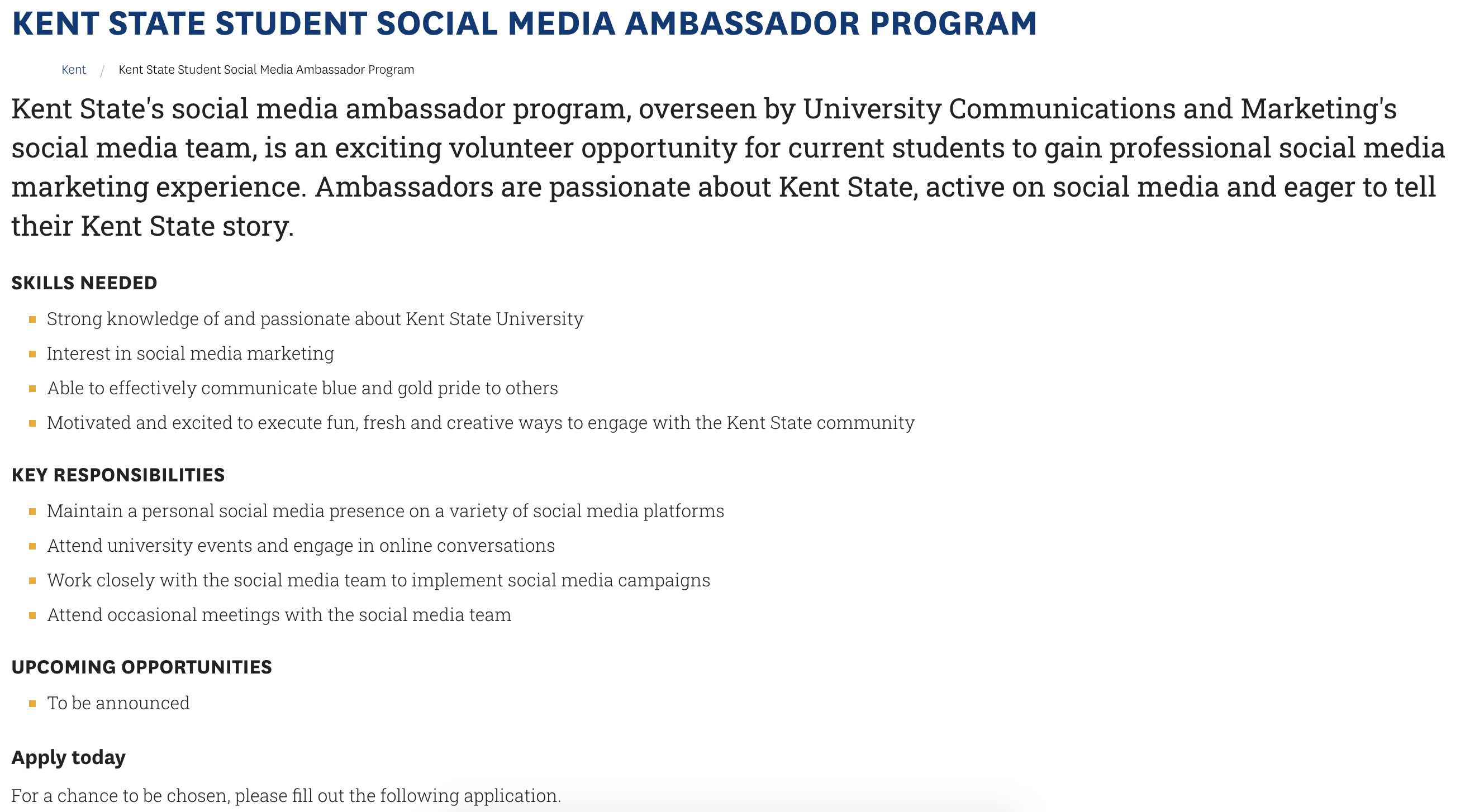
Be sure to promote this page far and wide if you want to reach as many potential applicants as possible.
Example: A Twitter post from the Public Relations chapter at the University of Tennessee promoting its social media ambassador program.
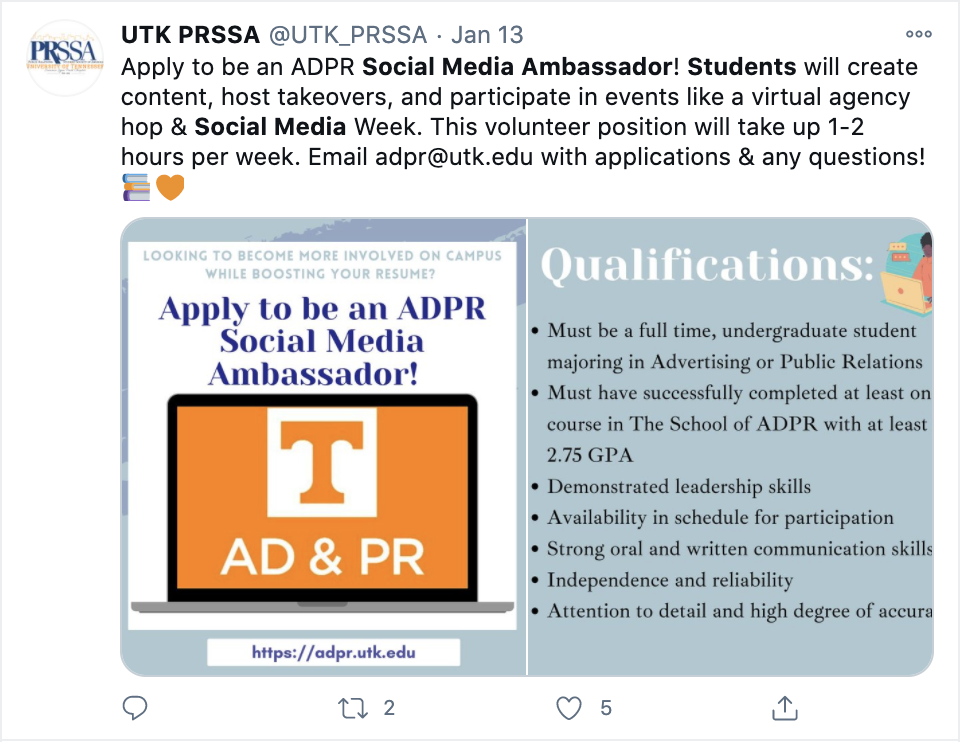
To decide which students make the final cut, most schools require applicants to fill out a form, as well as provide additional content to help schools get to know each student better.
Example: The student ambassador application requirements from Edinburgh Napier University

Measuring the Impact of Student Ambassadors on Your School’s Social Presence
As with any digital marketing tactic, it’s important to have a strategy for how you’re going to measure its success even before you carry it out.
Not only does this forward thinking help your school continuously optimize its strategy over time—it also ensures that every post is included in your measurements.
Keep in mind that, unlike other digital marketing tactics like sending emails or sharing blog posts, the content that your student ambassadors create are on their own profiles, not your school’s. This means that you can’t measure posts to the depth and detail you are used to with your school’s personal social media accounts.
However, that doesn’t mean that, if your school adopts this social media tactic, you’ll be taking a shot in the dark. You just need to make sure you create a clear monitoring strategy, and disseminate the needed information to your prospective students.
One way to gauge the effectiveness of your student brand ambassadors is to encourage them to use certain hashtags for specific types of posts.
Let’s say you want your student ambassadors to promote your online open day: you could encourage them to use a certain hashtag on these posts, and monitor that hashtag to see how much engagement each is generating. Hashtags can also be useful for keeping track of how many posts each social media ambassador is sharing for each campaign.
Example: This student ambassador from Rollins University frequently uses hashtags in their posts.

Another thing you could ask your student ambassadors to do is to include your school’s URL in their social media bios. This allows you to measure how many people visit your school’s website from an ambassador’s profile:
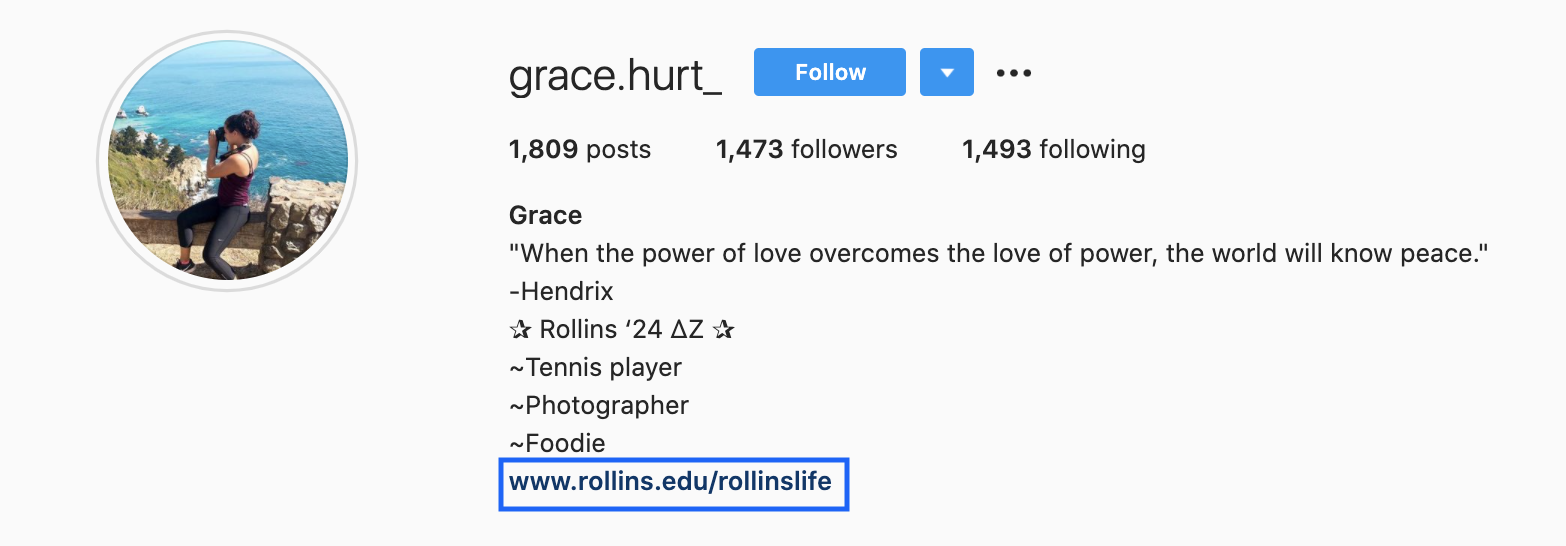
It’s also important to monitor the growth of your school’s social media channels following the introduction of a student ambassador program. If students are tagging your school in their posts, prospects will be encouraged to check out—and perhaps even follow—your school’s profiles as well.
Digital marketing data software like Google Analytics as well as many CRM and marketing automation platforms allow you to analyze engagement (such as likes and comments) as well as followers and reach over certain time periods. Some reporting tools also allow schools to compare social media performance over different time periods, so you can assess the impact of your social media ambassadors in contrast to other social media initiatives.
Example: The social media overview report in Google Analytics. You can measure performance by metrics such as overall sessions and conversions, as well as access data for individual social media platforms.
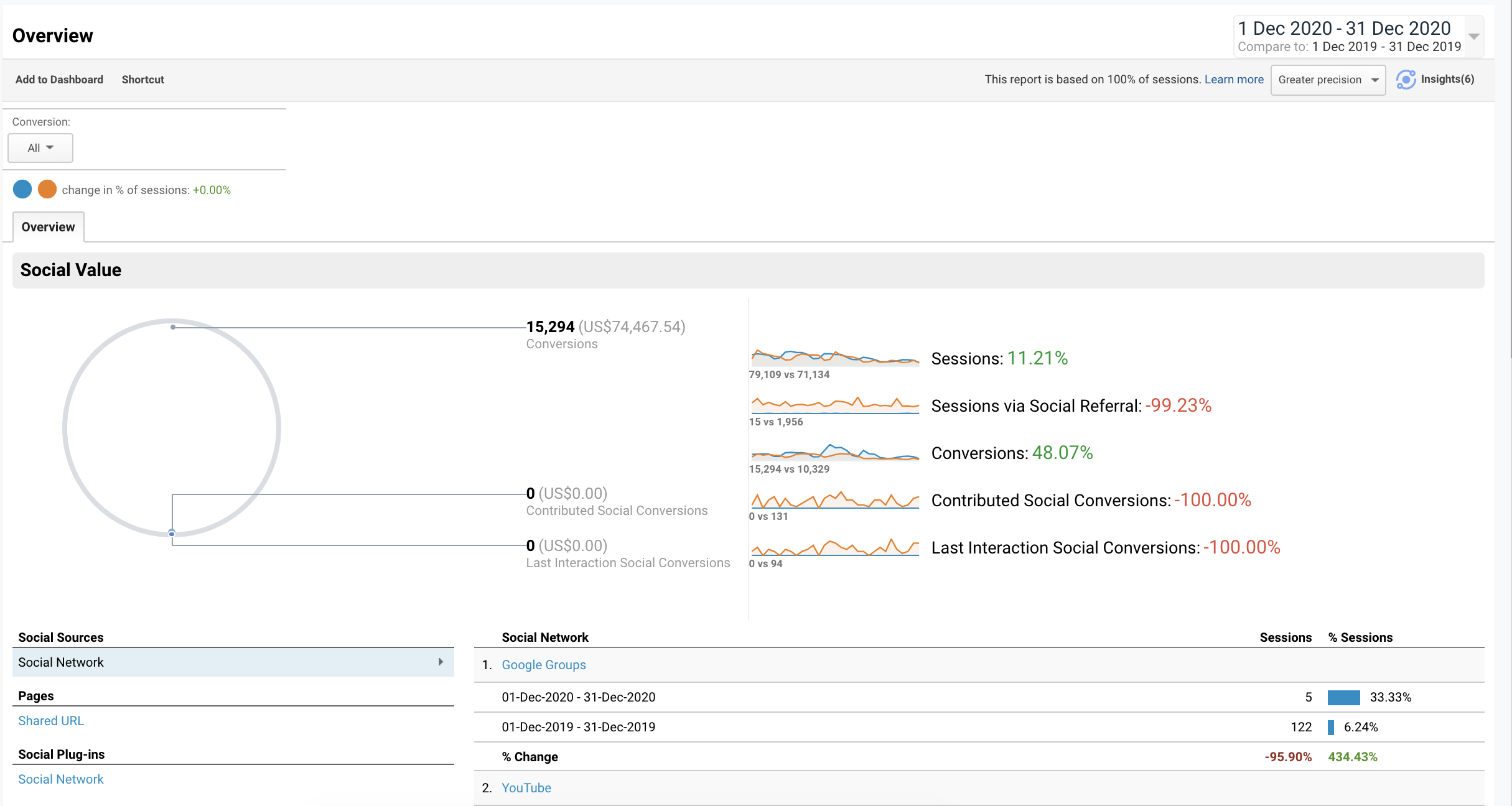
Keep in mind that there are other, non-measurable benefits of influencer marketing—namely, word of mouth. Student ambassadors are a great way to start a conversation about your school that may continue with prospects, as well as their friends and families, creating a ripple effect across a new audience of prospective students.






